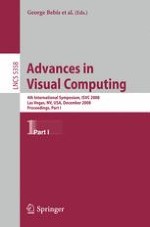It is with greatpleasure that we present the proceedings of the 4th International Symposium on Visual Computing (ISVC 2008) in Las Vegas, Nevada. ISVC o?ers a common umbrella for the four main areas of visual computing including vision, graphics, visualization, and virtual reality. Its goal is to provide a forum for researchers, scientists, engineers and practitioners throughout the world to present their latest research ?ndings, ideas, developments and applications in the broader area of visual computing. This year,ISVC grew signi?cantly; the programconsisted of 15 oralsessions, 1 poster session, 8 special tracks, and 6 keynote presentations. The response to the call for papers was very strong; we received over 340 submissions for the main symposium from which we accepted 102 papers for oral presentation and 70 papers for poster presentation. Special track papers were solicited separately through the Organizing and Program Committees of each track. A total of 56 papers were accepted for oral presentation and 8 papers for poster presentation in the special tracks. All papers were reviewed with an emphasis on potential to contribute to the state of the art in the ?eld. Selection criteria included accuracy and originality of ideas, clarity and signi?cance of results, and presentation quality. The review process was quite rigorous, involving two to three independent blind reviews followed by several days of discussion. During the discussion period we tried to correct anomalies and errors that might have existed in the initial reviews.
